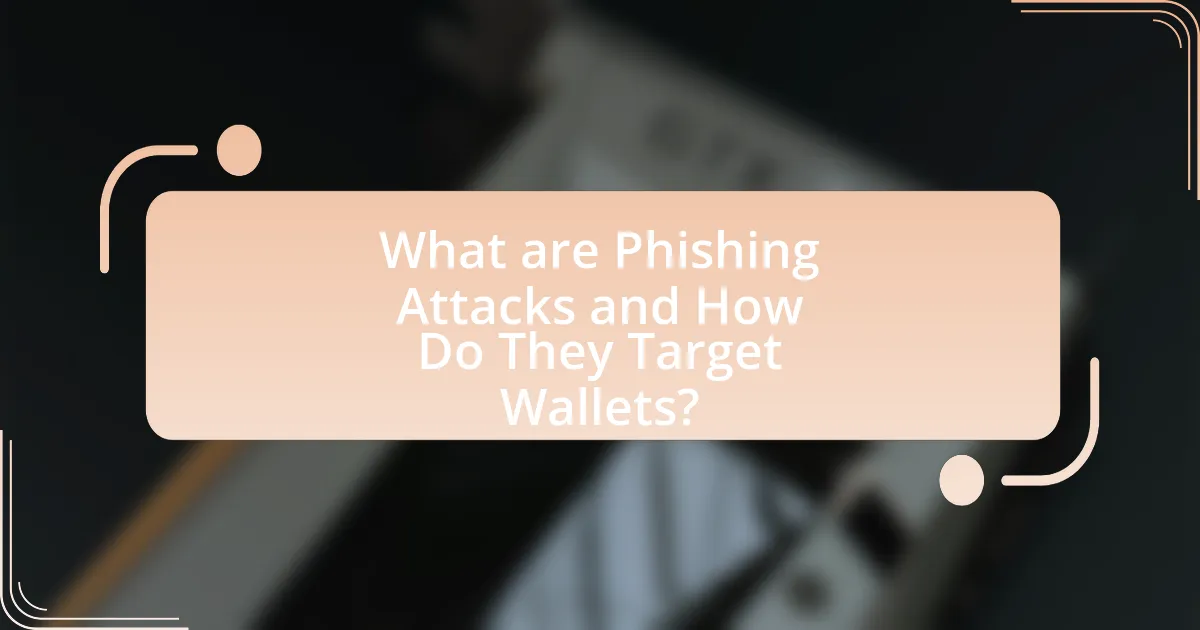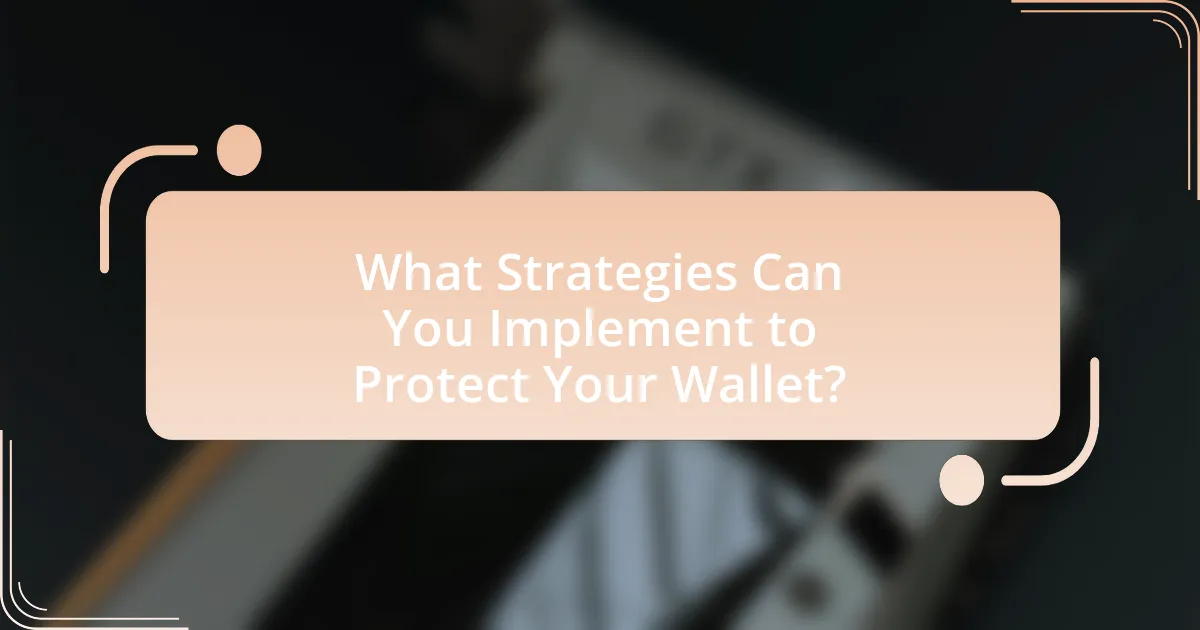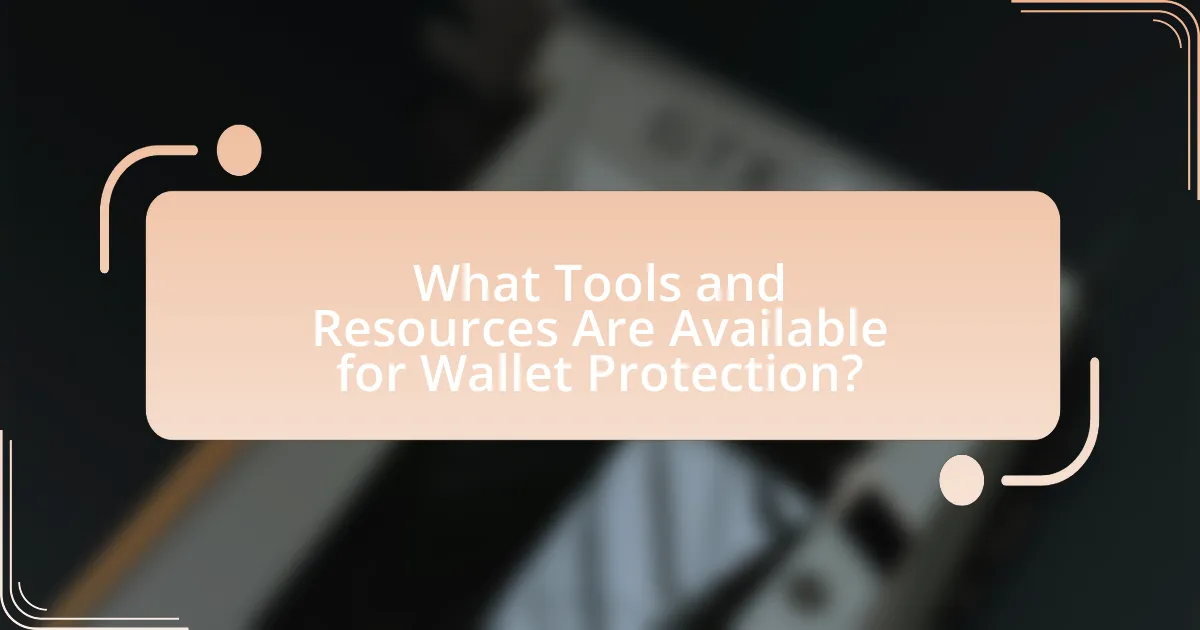Phishing attacks are deceptive tactics used by cybercriminals to obtain sensitive information, particularly targeting digital wallets. This article outlines the mechanisms of phishing attacks, including the techniques attackers use to deceive users and the vulnerabilities of digital wallets. It provides strategies for users to identify phishing attempts, enhance wallet security through multi-factor authentication, and utilize tools to protect against these threats. Additionally, the article emphasizes the importance of staying informed about the latest phishing trends and best practices for maintaining wallet security.

What are Phishing Attacks and How Do They Target Wallets?
Phishing attacks are deceptive attempts to obtain sensitive information, such as passwords or financial details, by masquerading as a trustworthy entity in electronic communications. These attacks specifically target wallets by sending fraudulent emails or messages that appear to be from legitimate wallet providers, prompting users to click on malicious links or provide personal information. According to the Anti-Phishing Working Group, there were over 200,000 phishing attacks reported in a single month in 2021, highlighting the prevalence of this threat. By exploiting social engineering tactics, attackers create a sense of urgency or fear, convincing users to act quickly and compromising their wallet security.
How do phishing attacks work in the context of digital wallets?
Phishing attacks in the context of digital wallets typically involve cybercriminals impersonating legitimate entities to deceive users into revealing sensitive information, such as passwords or private keys. These attacks often occur through fraudulent emails, messages, or websites that closely mimic official communications from wallet providers. For instance, a user may receive an email that appears to be from their digital wallet service, prompting them to click on a link that leads to a fake login page designed to capture their credentials. According to the Anti-Phishing Working Group, there were over 200,000 phishing attacks reported in the first quarter of 2021 alone, highlighting the prevalence of such tactics.
What techniques do attackers use to deceive wallet users?
Attackers use various techniques to deceive wallet users, including phishing emails, fake websites, and social engineering tactics. Phishing emails often impersonate legitimate services, tricking users into providing sensitive information. Fake websites mimic official wallet sites, capturing login credentials when users attempt to access their accounts. Social engineering tactics involve manipulating users into revealing personal information through trust-building conversations or urgent requests. According to a report by the Anti-Phishing Working Group, phishing attacks increased by 220% in 2020, highlighting the effectiveness of these deceptive techniques.
How can users identify phishing attempts targeting their wallets?
Users can identify phishing attempts targeting their wallets by scrutinizing the sender’s email address and looking for inconsistencies in URLs. Phishing emails often come from addresses that mimic legitimate sources but contain slight variations, such as misspellings or unusual domain names. Additionally, users should be cautious of unsolicited messages that urge immediate action, contain generic greetings, or request sensitive information. According to the Anti-Phishing Working Group, in 2022, 83% of phishing attacks involved email, highlighting the importance of vigilance in email communications.
Why are digital wallets particularly vulnerable to phishing attacks?
Digital wallets are particularly vulnerable to phishing attacks because they store sensitive financial information and are often accessed via mobile devices, which can be easily compromised. Phishing attacks typically involve deceptive emails or messages that trick users into providing their login credentials or personal information. According to a report by the Anti-Phishing Working Group, phishing attacks targeting financial services, including digital wallets, have increased significantly, with over 200,000 unique phishing sites reported in a single quarter. This rise is attributed to the growing popularity of digital wallets, making them attractive targets for cybercriminals.
What features of digital wallets make them attractive to attackers?
Digital wallets are attractive to attackers primarily due to their convenience and the sensitive information they store. The ease of access to funds and personal data, such as credit card numbers and identification, makes them a prime target for cybercriminals. Additionally, the reliance on internet connectivity and mobile devices increases vulnerability to phishing attacks, where attackers can impersonate legitimate services to steal credentials. According to a report by the Federal Trade Commission, losses from identity theft, including digital wallet fraud, reached over $3.3 billion in 2020, highlighting the significant risk associated with these features.
How does the increasing use of digital wallets impact phishing risks?
The increasing use of digital wallets elevates phishing risks by providing cybercriminals with more targets and methods for deception. As more individuals adopt digital wallets, attackers exploit the growing reliance on these platforms by creating sophisticated phishing schemes that mimic legitimate wallet notifications or transactions. According to a report by the Anti-Phishing Working Group, phishing attacks targeting financial services, including digital wallets, increased by 22% in 2021, highlighting the vulnerability associated with their widespread use. This trend indicates that as digital wallets become more prevalent, the potential for phishing attacks also escalates, necessitating heightened awareness and security measures among users.

What Strategies Can You Implement to Protect Your Wallet?
To protect your wallet from phishing attacks, implement multi-factor authentication (MFA) for all financial accounts. MFA significantly reduces the risk of unauthorized access by requiring additional verification methods beyond just a password, such as a text message code or biometric scan. According to a study by the Cybersecurity & Infrastructure Security Agency, accounts with MFA enabled are 99.9% less likely to be compromised. Additionally, regularly updating passwords and using unique passwords for different accounts further enhances security, as it minimizes the impact of a potential data breach.
How can you recognize and avoid phishing scams?
To recognize and avoid phishing scams, individuals should look for signs such as suspicious email addresses, poor grammar, and urgent requests for personal information. Phishing scams often use deceptive tactics to mimic legitimate organizations, making it crucial to verify the sender’s identity before responding. For instance, according to the Anti-Phishing Working Group, 75% of phishing emails contain links that lead to fraudulent websites. Users should also avoid clicking on links or downloading attachments from unknown sources, as these can lead to malware installation. Additionally, employing security software and enabling two-factor authentication can provide extra layers of protection against phishing attempts.
What are the signs of a phishing email or message?
Phishing emails or messages often exhibit several key signs that indicate their fraudulent nature. Common signs include poor spelling and grammar, which can suggest a lack of professionalism; generic greetings such as “Dear Customer” instead of using the recipient’s name; and urgent language that pressures the recipient to act quickly, often claiming that immediate action is required to secure an account. Additionally, phishing attempts frequently contain suspicious links or attachments that may lead to malicious websites or malware. According to the Anti-Phishing Working Group, over 70% of phishing emails contain these characteristics, reinforcing the importance of vigilance when assessing the authenticity of communications.
How can you verify the authenticity of wallet-related communications?
To verify the authenticity of wallet-related communications, always check the sender’s address and ensure it matches the official source. Phishing attacks often use spoofed email addresses or fake websites that closely resemble legitimate ones. Additionally, look for signs of secure communication, such as HTTPS in URLs and proper spelling and grammar in messages. According to the Anti-Phishing Working Group, over 75% of phishing attacks involve fraudulent emails that can be identified through these checks. Always cross-reference any communication with official channels or customer support to confirm its legitimacy.
What security measures should you adopt for your digital wallet?
To secure your digital wallet, adopt measures such as enabling two-factor authentication (2FA), using strong, unique passwords, and regularly updating your software. Two-factor authentication adds an extra layer of security by requiring a second form of verification, which significantly reduces the risk of unauthorized access. Strong passwords, ideally a combination of letters, numbers, and symbols, prevent easy guessing or brute-force attacks. Regular software updates ensure that your wallet benefits from the latest security patches, protecting against vulnerabilities that could be exploited by attackers. According to a 2021 report by Cybersecurity Ventures, 2FA can block up to 99.9% of automated attacks, highlighting its effectiveness in enhancing digital wallet security.
How can two-factor authentication enhance wallet security?
Two-factor authentication (2FA) enhances wallet security by requiring an additional verification step beyond just a password. This additional layer significantly reduces the risk of unauthorized access, as even if a password is compromised, the attacker would still need the second factor, typically a code sent to a mobile device or generated by an authentication app. According to a study by Google, implementing 2FA can block 99.9% of automated attacks, demonstrating its effectiveness in safeguarding sensitive information, including digital wallets.
What role do strong passwords play in protecting your wallet?
Strong passwords are essential for protecting your wallet from unauthorized access and potential theft. They serve as the first line of defense against cybercriminals who attempt to gain access to sensitive financial information. A strong password typically includes a combination of uppercase and lowercase letters, numbers, and special characters, making it significantly harder for attackers to crack through brute force methods. According to a study by the National Institute of Standards and Technology (NIST), weak passwords can be compromised in seconds, while strong passwords can take years to break, thereby greatly enhancing the security of your wallet.

What Tools and Resources Are Available for Wallet Protection?
Tools and resources available for wallet protection include hardware wallets, software wallets with strong encryption, and multi-factor authentication (MFA) systems. Hardware wallets, such as Ledger and Trezor, store private keys offline, significantly reducing the risk of online attacks. Software wallets, like Exodus and Electrum, offer encryption and backup features to safeguard assets. Multi-factor authentication adds an extra layer of security by requiring additional verification steps, making unauthorized access more difficult. According to a report by the Cybersecurity and Infrastructure Security Agency (CISA), implementing these tools can reduce the likelihood of successful phishing attacks on digital wallets.
What software can help protect against phishing attacks?
Software that can help protect against phishing attacks includes antivirus programs, email filtering solutions, and web browsers with built-in security features. Antivirus programs like Norton and McAfee offer real-time protection against malicious links and phishing attempts. Email filtering solutions such as Proofpoint and Mimecast can identify and block phishing emails before they reach the inbox. Additionally, web browsers like Google Chrome and Mozilla Firefox have features that warn users about potentially harmful websites, enhancing security against phishing threats. These tools collectively reduce the risk of falling victim to phishing attacks by providing multiple layers of defense.
How do anti-phishing tools work to safeguard your wallet?
Anti-phishing tools safeguard your wallet by detecting and blocking fraudulent websites and emails designed to steal sensitive information. These tools utilize algorithms to analyze URLs and email content for known phishing patterns, such as suspicious links or deceptive language. For instance, according to a report by the Anti-Phishing Working Group, there was a 22% increase in phishing attacks in 2021, highlighting the necessity for such protective measures. By employing real-time threat intelligence and machine learning, anti-phishing tools can adapt to new phishing tactics, ensuring that users are protected against evolving threats.
What are the best practices for using security software effectively?
To use security software effectively, regularly update the software to ensure it has the latest protection against threats. Keeping security software up to date is crucial because cyber threats evolve rapidly, and outdated software may not recognize new malware or phishing attempts. Additionally, users should configure the software settings to maximize protection, such as enabling real-time scanning and automatic updates. According to a report by the Cybersecurity & Infrastructure Security Agency, organizations that maintain updated security software reduce their risk of successful cyber attacks significantly. Furthermore, users should conduct regular scans of their systems to identify and eliminate potential threats proactively. This practice is supported by findings from the Ponemon Institute, which indicate that organizations that perform regular security assessments are better equipped to defend against phishing attacks.
How can you stay informed about the latest phishing threats?
To stay informed about the latest phishing threats, regularly follow cybersecurity news websites and subscribe to threat intelligence feeds. Websites like Krebs on Security and the Cybersecurity & Infrastructure Security Agency (CISA) provide timely updates on emerging phishing tactics and trends. Additionally, subscribing to newsletters from reputable cybersecurity firms, such as Symantec or McAfee, can deliver insights directly to your inbox. Engaging with online communities and forums focused on cybersecurity, such as Reddit’s r/cybersecurity, can also help you share and receive information about recent phishing scams.
What resources provide updates on phishing trends and tactics?
Resources that provide updates on phishing trends and tactics include cybersecurity blogs, threat intelligence platforms, and government cybersecurity agencies. For example, the Anti-Phishing Working Group (APWG) publishes regular reports on phishing trends, while organizations like Symantec and McAfee offer insights through their blogs and threat reports. Additionally, the Federal Trade Commission (FTC) and the Cybersecurity and Infrastructure Security Agency (CISA) provide valuable information and alerts regarding phishing tactics and prevention strategies. These resources are essential for staying informed about the evolving landscape of phishing threats.
How can community forums and groups help in sharing information about phishing attacks?
Community forums and groups facilitate the sharing of information about phishing attacks by providing a platform for users to report incidents, share experiences, and disseminate knowledge on prevention strategies. These platforms enable real-time communication, allowing members to alert each other about new phishing schemes and tactics, which can significantly enhance collective awareness. For instance, a study by the Anti-Phishing Working Group reported that community-driven alerts can reduce the time it takes to identify and respond to phishing threats, thereby minimizing potential damage. Additionally, forums often host discussions that educate users on recognizing phishing attempts, further empowering individuals to protect themselves and their wallets.
What are the best practices for maintaining wallet security?
The best practices for maintaining wallet security include using strong, unique passwords, enabling two-factor authentication, and regularly updating wallet software. Strong passwords should consist of a mix of letters, numbers, and symbols, making them difficult to guess. Two-factor authentication adds an extra layer of security by requiring a second form of verification, such as a text message or authentication app. Regular updates to wallet software ensure that any security vulnerabilities are patched, reducing the risk of exploitation. According to a report by the Cybersecurity & Infrastructure Security Agency, implementing these practices significantly decreases the likelihood of unauthorized access and phishing attacks.
How often should you update your wallet security settings?
You should update your wallet security settings at least every three to six months. Regular updates help protect against evolving phishing threats and vulnerabilities. Cybersecurity experts recommend this frequency to ensure that your security measures remain effective against new attack vectors, as phishing tactics are constantly changing. Additionally, if you notice any suspicious activity or receive alerts about potential breaches, you should update your settings immediately to mitigate risks.
What steps should you take if you suspect a phishing attempt?
If you suspect a phishing attempt, immediately cease any interaction with the suspicious message or website. This includes not clicking on links or downloading attachments. Next, verify the authenticity of the communication by contacting the organization directly through official channels, not through any contact information provided in the suspicious message. Additionally, report the phishing attempt to relevant authorities, such as the Federal Trade Commission (FTC) in the United States or your email provider, to help prevent others from falling victim. Finally, consider changing your passwords and enabling two-factor authentication on your accounts to enhance security.